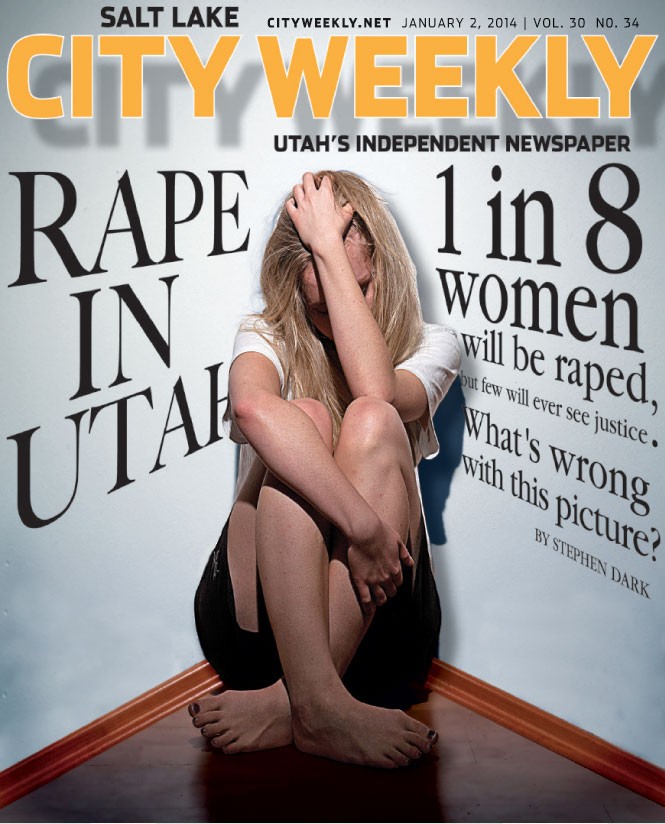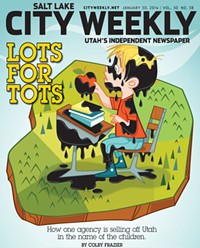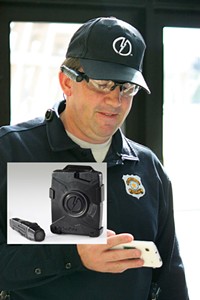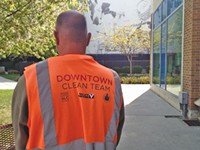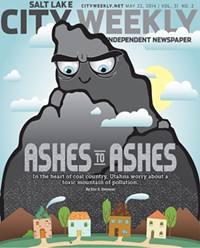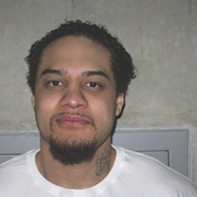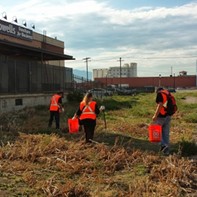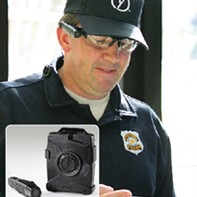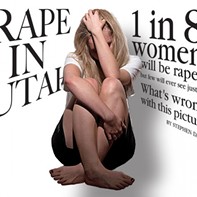More News Is Good News
Updates on City Weekly's 2014 reporting
By Stephen Dark @stephenpdark, Colby Frazier @colbyfrazierlp and Eric S. Peterson @ericspetersonFrom a fatal shooting inside the new federal courthouse to shedding light on law enforcement's relaxed approach to processing rape kits, City Weekly reporters sought in 2014 to report and break stories that were mere footnotes in other media outlets. Here is a highlight reel of stories we covered, and have continued to follow throughout the year.
Rape Cases On Dec. 19, 2014, Jessica Ripley finally got an answer to a question she'd been asking since she was sexually assaulted by a man she'd danced with at a downtown Salt Lake City nightclub in February 2012.
What had happened to the rape kit a sexual-assault nurse examiner had taken from Ripley at the LDS Hospital in the early hours of the morning after the assault?
Ripley's story of being raped and subsequently not believed by responding officers was featured in a January 2014 City Weekly cover story called "Rape in Utah." She had sought answers from SLCPD about what had happened to her case for months after the initial investigation fizzled out. She eventually learned that the Salt Lake County District Attorney's office had declined to prosecute her case, but the fate of her rape kit—known as a Code R kit—remained a mystery.
In August 2014, she e-mailed SLCPD seeking information on her case. Her December 2014 meeting with Sgt. Lisa Pascadlo, executive officer to Chief Chris Burbank, was, with the exception of the initial interview by a responding officer, "the first time I ever met anyone face to face on my case," Ripley says.
Pascadlo told her that evidence taken that night by the nurse had yielded traces of semen, and DNA from Ripley's rapist had been uploaded to the national Combined DNA Index System in April 2012.
"Rape in Utah" also highlighted a study by BYU professor and SANE nurse Julie Valentine, whose data found that the vast majority of rape cases in Salt Lake County were not prosecuted. Other findings were equally alarming. Cops rarely believed victims, few cases were screened with prosecutors, and those that were usually ended up being declined. In addition, most rape kits idled on shelves in police departments rather than being submitted to the state crime lab for testing.
Much has changed since Ripley's story and Valentine's report were published in City Weekly. SLCPD started a Code R kits project in late spring 2014, committing four sex-crimes detectives to reviewing all cases involving unprocessed rape kits and then publishing the results online, without identifying the victim. This came after criticism from SLC councilman Kyle LaMalfa regarding untested kits, which numbered nearly 700 at SLCPD alone. SLCPD also signed up to join four other cities as part of a Department of Justice-funded year-long review of rape cases to determine best practices.
Valentine is grateful for the pressure that the Salt Lake City Council brought to bear on law enforcement, "influencing the move to submit all Code R kits to crime lab." On Dec. 3, 2014, the council voted unanimously to have all rape kits tested.
She is in the midst of a new study of West Valley City Police Department, looking at the impact on how rape cases are investigated and prosecuted after officers have been trained in "the neurobiology of sexual assault trauma." She will be announcing findings at an early January 2015 conference on sexual assault and law enforcement.
Ripley is puzzled why SLCPD took so long to tell her about her kit. "It's kind of strange they had it the whole time and are now just giving it to me," she says. In response to an e-mailed query, Pascadlo replied that "there is no policy requiring notification to a victim."
Despite that, Ripley says her joy at her assailant's DNA being available to police departments across the country to identity him if he attacks someone else is indescribable. "I can't even explain what comfort it brings to me," she says, knowing that something had actually been done about her rapist. "I feel like a little bit of justice has been served on my part."
Ripley's newfound media profile—she appeared on Fox 13, KUTV and KSL and gave a speech at the 2014 Slut Walk—led to customers at the pharmacy she works at sharing stories of sexual assault they had been unable to report to law enforcement. "It's been the shittiest experience I've ever gone through," Ripley says. "But if you don't report it, you're letting that person win."
SITLA Makes Millions Acting quietly and relentlessly, the State & Institutional Trust Lands Administration's efforts to turn Utah lands that belong to the state's schoolchildren into money—a mission explored in the January cover story "Lots for Tots"—had another successful year.
Among the highlights was the $8.8 million sale of 193 acres in St. George to Jack Fisher Homes, which builds facilities for "active adults." The development will include 600 residential units.
In its year-end report, the administration, known as SITLA, also made note that the state's first tar-sands development, located at PR Springs in Uintah County on 32,000 acres, received some pertinent permits and is moving forward with development. The lands that SITLA manages, widely referred to by state lawmakers as school-child land, were gifted to Utah by the federal government at statehood.
All told, SITLA, largely through leasing and selling land to oil companies, roped in $139 million dollars in revenue. Of that, $9.5 million went to operating expenses. SITLA, which operates to the extent that it can as a private business, unencumbered by some of the oversight that would be given to a bona fide state agency, deposited $130.4 million into its "permanent school trust fund," a portion of which—$40.4 million—was distributed to the state's public schools. In all, SITLA's trust fund carries nearly $2 billion.
Unlike the federal Bureau of Land Management, which must provide access to myriad uses on the millions of acres it manages in the state, SITLA has but one mandate: to monetize the school-child land, a mission that may well come under the microscope as Utah continues its efforts to wrest the lion's share of public land away from the BLM.
Body Cam O' Rama In January, City Weekly reported on the Salt Lake City Police Department's enthusiastic adoption of body cameras for its officers. Body cameras have only recently been embraced by police departments, and Salt Lake was considered a trailblazer for using the cameras, vowing to buy one for every single officer. At the time, SLCPD had just spent $269,493 for 80 of the cameras, bringing its cache to 95.
The controversial and fatal police shooting of an unarmed man in Ferguson, Mo., brought the debate surrounding the importance of cameras to the mainstream.
The violence, though, struck even closer to home. On Aug. 11, a Salt Lake City police officer gunned down Dillon Taylor. Body camera footage showed that officer Bron Cruz ran after Taylor, demanding that he remove his hands from his pockets. Taylor continually refused and, after pulling up his shirt, was fatally shot. The video footage was cited by police officials as vindicating Cruz's actions. A month later, on Sept. 10, police in Saratoga Springs fatally shot Darrien Hunt, who allegedly swung a samurai sword at officers. Prosecutors said both shootings were justified.
In the past few months, SLCPD spent $673,600 on 200 more cameras. It now has 295 cameras, one for all of its front-line, first-responding patrol officers. The cameras, which cost SLCPD $3,368 apiece, must be manually turned on and require loads of data-storage capacity.
Salt Lake City's pioneering role in adopting the cameras has brought other departments to its doorstep seeking advice.
Detective Greg Wilking says as interest in the cameras has grown, departments from across the country have inquired about how Salt Lake City makes use of them. And, in the case of Taylor, he says the camera footage shows that the officer was in the right.
"Tragic as it was, the officer ended up being cleared because that information was available," Wilking says.
And now, if Gov. Gary Herbert gets his wish, the state's police will soon be wearing body cameras. Herbert penciled $1 million into this year's budget for the purchase of body cameras, with the goal of eventually having one for every state trooper.
Downtown Clean Streets Team The Salt Lake City Clean Streets Team was the focus of the April news story "Cleaning the Mean Streets." The program, which started in 2013, gives part-time work to homeless Salt Lake City residents cleaning up around The Road Home shelter to give them work experience and help them transition into something more permanent.
The team is funded through a collaboration between the Downtown Alliance, Salt Lake City and Advantage Services (formerly Valley Services) that specifically employs people who struggle to find work because of criminal backgrounds or other deterrents.
Camille Winnie of the Downtown Alliance says the Clean Streets Team will continue to be funded into 2015, thanks to support from partners and donations from private companies such as American Express and GE Capital.
For the April story, City Weekly interviewed two homeless members of the team, Dave and Beth, who have now joined more than a dozen other team members who have transitioned to full-time employment.
Winnie says that in 2015, the program will vie for new city contracts to do clean up along the airport/North Temple Trax line and others that will help the program expand.
Pens Still Raised In April, Utah's new federal courthouse made national and international headline when Siale Angilau, an alleged member of the Tongan Crips gang, was fatally shot and killed by a U.S. Marshal after he rushed toward a witness who was testifying against him, holding either a pen or a pencil, according to witnesses.
Angilau's death sent shockwaves through Utah's Pacific Islander community, and in the aftermath of the shooting, a youth movement, Raise Your Pen, was formed.
The group has been raising awareness of the challenges faced by minorities in Utah and of the heavy-handed tactics used against Angilau—both in his death and in the federal racketeering charges filed against him. Angilau's attorney Michael Langford questioned why a charge usually reserved for the mafia would be used against clients like his, who was prosecuted for "beer run" convenience stores robberies.
Since the shooting, the FBI has ruled that the Marshall was justified in using lethal force, and has also refused to release courtroom video of the incident.
Besides joining many other groups in rallying against police brutality, Raise Your Pen is also currently crowdfunding to raise money to try to legally gain access to the courtroom video. More info on the campaign can be found at the Raise Your Pen Coalition Facebook page: http://citywk.ly/RaiseYourPen
What a Waste Coal ash, a byproduct of coal-fired plants, has been largely unregulated, despite the fact that it's one of the largest waste streams in the country. According to the Environmental Protection Agency, in 2012, 470 coal-fired electric utilities burned more than 800 million tons of coal, in turn generating approximately 110 million tons of coal ash in 47 states and Puerto Rico. The waste is usually deposited in ponds or landfills—like the 75-acre landfill in East Carbon, a rural community in Carbon County.
In the May cover story "Ashes to Ashes," City Weekly looked at the landfill and the fight that East Carbon residents had against the proposed expansion of the landfill.
Environmental advocates have assailed the waste product because of the toxic chemicals in the ash, which range from lead and selenium to arsenic. In Utah, state regulators allowed the East Carbon landfill to not be required to have a liner under the giant ash pile and, in 2013, approved a 34-acre expansion of the landfill that would also not require the installation of a liner, which, some have argued, would keep the toxic ash from leaching into groundwater.
Regulators with the Utah Department of Water Quality say there is a layer of Mancos shale under the landfill that acts as a natural barrier, but in a legal challenge, Brigham Young University geologist Steve Nelson challenged the claim. Nelson compared the chemicals underneath the landfill to those outside of it and found that the level of contaminates consistently spiked under the landfill as opposed to outside of it. Those appeals are still in process and briefings aren't expected until early 2015.
In the meantime, the EPA has finally issued a rule on federal regulation of coal ash.
As You Sow is a nonprofit group advocating corporate responsibility on key matters, coal ash being one of them. As You Sow's Amelia Timbers, the energy program manager, says the new rule has some pluses—the phasing out of ash ponds, more transparency and requirements for liners on new landfills—but otherwise is a "disappointment."
"It's pretty clear to us that the EPA bowed to industry pressure on this rule," Timbers says. She points out that despite the "deeply toxic" ingredients in coal ash, that the EPA classified it as "solid waste," putting it in the same category as garbage, as opposed to hazardous waste. She's also troubled that the EPA left enforcement of the rule up to the states.
"States were already supposed to be preventing the harm that comes from coal ash and weren't," Timbers says.
More by Stephen Dark
-
Call it a Comeback
Long mired in economic depression, Midvale’s Main Street dusts off its small-town charm.
- Sep 20, 2017
-
Love Letters
Correspondence between a young woman at the Topaz internment camp and her beloved sheds light on Trump's America.
- Sep 6, 2017
-
Triggered
Veterans Affairs exists to help vets. So why did the Salt Lake VA appoint an anti-veteran chief?
- Aug 30, 2017
- More »
More by Eric S. Peterson
-
The Secret Sauce
How Utah lawmakers disclose—or don't disclose—conflicts of interest.
- Feb 14, 2024
-
Police departments in Salt Lake County spent almost $20 million on civil rights complaints in the past decade
The Co$t of Mi$conduct
- Oct 18, 2023
-
Women decry harassment and toxic culture at St. George auto dealership
Men at Work
- Oct 11, 2023
- More »
More by Colby Frazier
-
Fire Line
UFA Board considers recouping bonuses paid to former chiefs and turning investigation over to law enforcement.
- Jan 25, 2017
-
Home Sweet Home?
How a single real estate deal highlights a city in flux and in crisis.
- Jan 4, 2017
-
Dead Red
That Utah could end up voting something other than Republican proved delusional.
- Nov 9, 2016
- More »
Latest in News
Readers also liked…
-
Raise a glass for E.L.T Harrison, architect of the Beerhive building on Main
Small Lake City
- Oct 11, 2023


